Résultats de recherche de titre
Articles 1494141 à 1494160 sur 1497673

Where the Hood At?: Fifty Years of Change in Black Neighborhoods
Par Michael C. Lens. 2024
Substantial gaps exist between Black Americans and other racial and ethnic groups in the U.S., most glaringly Whites, across virtually…
all quality-of-life indicators. Despite strong evidence that neighborhood residence affects life outcomes, we lack a comprehensive picture of Black neighborhood conditions and how they have changed over time. In Where the Hood At? urban planning and public policy scholar Michael C. Lens examines the characteristics and trajectories of Black neighborhoods across the U.S. over the fifty years since the Fair Housing Act. Hip hop music was born out of Black neighborhoods in the 1970s and has evolved alongside them. In Where the Hood At? Lens uses rap’s growth and influence across the country to frame discussions about the development and conditions of Black neighborhoods. Lens finds that social and economic improvement in Black neighborhoods since the 1970s has been slow. However, how well Black neighborhoods are doing varies substantially by region. Overall, Black neighborhoods in the South are doing well and growing quickly. Washington D.C. and Atlanta, in particular, stand out as centers of Black affluence. Black neighborhoods in the Midwest and the Rust Belt, on the other hand, are particularly disadvantaged. The welfare of Black neighborhoods is related not only to factors within neighborhoods, such as the unemployment rate, but also to characteristics of the larger metropolitan area, such as overall income inequality. Lens finds that while gentrification is increasingly prevalent, it is growing slowly, and is not as pressing an issue as public discourse would make it seem. Instead, concentrated disadvantage is by far the most common and pressing problem in Black neighborhoods. Lens argues that Black neighborhoods represent urban America’s greatest policy failures, and that recent housing policies have only had mild success. He provides several suggestions for policies with the goal of uplifting Black neighborhoods. One radical proposal is enacting policies and programs, such as tax breaks for entrepreneurs or other small business owners, that would encourage Black Americans to move back to the South. Black Americans migrating South would have a better chance at moving to an advantaged Black neighborhood as improving neighborhood location is higher when moving across regions. It would also help Black Americans expand their political and economic power. He also suggests a regional focus for economic development policies, particularly in the Midwest where Black neighborhoods are struggling the most. One way to boost economic development would be to move federal agencies to the area. He also calls for building more affordable housing in Black suburbs. Black poverty is lower in suburbs than in central cities, so increasing housing in Black suburbs would allow Black households to relocate to more advantaged neighborhoods, which research has shown leads to improved life outcomes. Where the Hood At? is a remarkable and comprehensive account of Black neighborhoods that helps us to better understand the places and conditions that allow them flourish or impedes their advancement.
Dreams Achieved and Denied: Mexican Intergenerational Mobility (American Sociological Association's Rose Series)
Par Robert Courtney Smith. 2024
U.S.-born Mexicans in New York City have achieved perhaps the biggest single generation jump in mobility in American immigration history.…
In 2020, 42-percent of second-generation U.S.-born Mexican men and 49-percent of U.S.-born Mexican women in New York City had graduated from college – versus a 13-14-percent second-generation college graduation rate for most places for most studies done in recent decades. How did U.S.-born Mexicans in New York City achieve such remarkable mobility? In Dreams Achieved and Denied, sociologist Robert Courtney Smith examines the laws, policies, and individual and family practices that promoted – and inhibited – their social mobility. For over twenty years, Smith followed the lives and mobility of nearly one hundred children of Mexican immigrants in New York City. Smith’s longitudinal, ethnographic data enabled him to intimately describe how specific mechanisms blocked or promoted mobility for years as his participants moved from adolescence through early adulthood and into established adulthood. Smith documents how having or gaining legal status made certain New York City or New York State policies and practices more efficacious in supporting individual and family efforts and strategies for mobility. Such immigrant-inclusive and mobility-promoting measures include enabling undocumented people to attend public colleges at in-state tuition rates, and later to get driver’s licenses, offering healthcare to all in New York City, and the City’s subway and school choice systems, which enabled students to attend better schools or take opportunities outside their neighborhoods. Smith finds that keeping the immigrant bargain – whereby children of immigrants redeem their parents’ sacrifice by doing well in school, helping their parents and siblings, and becoming “good” people (in their parents’ words) – helped them towards better adult outcomes and lives. Having mentors, picking academically stronger schools and friends, and using second chance mechanisms also promoted more adult mobility. However, lacking legal status blocked mobility, by preventing them from benefiting from these same mobility-promoting city and state policies, from mentors, or from working hard and keeping the immigrant bargain. Dreams Achieved and Denied deeply analyzes the historic upward mobility of U.S.-born Mexicans in New York City. Itcounters the dominant story research and public discourse tell about Mexican mobility in the U.S. and shows how thoughtful public policy can improve the lives of young immigrants and families.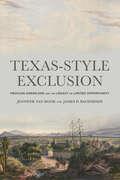
Texas-Style Exclusion: Mexican Americans and the Legacy of Limited Opportunity
Par James D. Bachmeier, Jennifer Van Hook. 2024
While Americans largely support legal immigration, this support is conditional on the basis that immigrants do not make use of…
public assistance. Previous generations of immigrants, such as European-origin Industrial Era immigrants, came to U.S. impoverished, worked hard, and achieved the American Dream seemingly on their own. Mexican immigrants, the nation’s largest contemporary immigrant group, are often viewed with suspicion and are accused of being dependent on the government and refusing to integrate into American society the “right way.” In Texas-Style Exclusion, sociologists Jennifer Van Hook and James D. Bachmeier investigate such claims by comparing how American society has responded to different groups of immigrants over time. Drawing on census and archival data on the quality of public schooling, Van Hook and Bachmeier find that Industrial Era European immigrants, who were primarily located in the northeastern U.S., benefited from programs and policies championed by the Americanization and Progressive movements. The Americanization movement sought to help acclimate new arrivals and transform “foreigners” into “Americans” by providing night school programs to promote civic integration and basic education, as well as other services. The Progressive movement, which aimed to improve education, work, and health conditions, sought to expand investment in public schools and make primary and secondary schooling mandatory, which kept working class children in school as opposed to entering the workforce. This access to education allowed for integration and astonishing intergenerational mobility. Mexican immigrants in the 1920s and 1930s, the majority of whom resided in Texas, had radically different experiences from their European counterparts. Mexicans in Texas were subjected to racism, segregation, labor exploitation, and intentional school failures. This resulted in tremendous generational disadvantage that persists to the current day. Mexicans from this cohort who left Texas for states with strong Americanization and Progressive movements saw improved educational outcomes and integration. Additionally, Mexicans who immigrated after the Civil Rights Movement saw significantly greater inter-generational mobility and educational attainment than earlier cohorts due to the protections provided by civil rights laws. Van Hook and Bachmeier conclude that whether one is optimistic or pessimistic about the integration of Mexican Americans depends on when and where one looks. Texas-Style Exclusion is an engaging examination of policies and practices that have been glossed over and forgotten that promoted mobility and integration for certain immigrant groups and impeded them for others.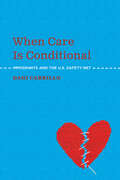
When Care is Conditional: Immigrants and the U.S. Safety Net
Par Dani Carrillo. 2024
From its inception, the public safety net in the United States has excluded many people because of their race, gendered…
roles, or other factors. As a result, they must prove their moral worthiness to get resources for themselves and their families. In When Care Is Conditional, sociologist Dani Carrillo reveals the ramifications of this conditional safety net by focusing on one particularly vulnerable population: undocumented immigrants. Through in-depth interviews with Latinx immigrants in northern California, Carrillo examines three circumstances—place, gender, and immigration status—that intersect to influence an individual’s access to health care, food assistance, and other benefits. She demonstrates that place of residence affects undocumented immigrants’ ability to get care since more services are available in urban areas, where many immigrants cannot afford to live, than suburban areas, where public transportation is limited. She also shows that while both men and women who are undocumented have difficulty obtaining care, men often confront more challenges. Undocumented women who are pregnant or mothers are eligible for some government safety net programs and rely on informal coethnic networks or a “guiding figure”—a relative, friend, neighbor, or coworker—who explains how to get care and makes them feel confident in accessing it. Most undocumented men, in contrast, are not eligible for public programs except in a medical emergency and often lack someone to guide them directly to care. Men sometimes steer one another to jobs through worker centers—where they may learn about various services and take advantage of those that increase their employability, like English or computer classes—but a culture of masculinity leads them to downplay medical problems and seek health care only in a crisis. As undocumented immigrants navigate this exclusionary system, Carrillo finds that they resist the rhetoric stigmatizing them as lawbreakers. Dismissing the importance of “papers” and highlighting their work ethic, they question the fairness of U.S. immigration policies and challenge ideas about who deserves care. Carrillo offers concrete recommendations, such as improving labor conditions and reexamining benefit eligibility, to increase access to care for not only undocumented immigrants but also people who have been excluded because of their race, criminal record, gender identity, sexual orientation, or disability. She argues that working with and across populations creates a powerful form of solidarity in advocating for inclusive care. When Care Is Conditional provides compelling insights into how safety net and immigration policies intersect to affect people’s everyday lives and calls for a cultural shift so that the United States can provide unconditional care for all.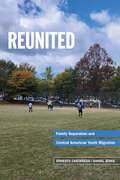
Reunited: Family Separation and Central American Youth Migration
Par Ernesto Castañeda, Daniel Jenks. 2024
In the second decade of the twenty-first century, an increasing number of children from El Salvador, Honduras, and Guatemala began…
arriving without parents at the U.S.-Mexico border. In many cases, the parents had left for the United States years earlier to earn money that they could send back home. In Reunited sociologists Ernesto Castañeda and Daniel Jenks explain the reasons for Central American youths’ migration, describe the journey, and document how the young migrants experience separation from and subsequent reunification with their families. In interviews with Central American youth, their sponsors, and social services practitioners in and around Washington, D.C., Castañeda and Jenks find that Central American minors migrate on their own mainly for three reasons: gang violence, lack of educational and economic opportunity, and a longing for family reunification. The authors note that youth who feel comfortable leaving and have feelings of belonging upon arrival integrate quickly and easily while those who experience trauma in their home countries and on their way to the United States face more challenges. Castañeda and Jenks recount these young migrants’ journey from Central America to the U.S. border, detailing the youths’ difficulties passing through Mexico, proving to U.S. Customs and Border Protection officials that they have a legitimate fear of returning or are victims of trafficking, and staying in shelters while their sponsorship, placement, and departure are arranged. The authors also describe the tensions the youth face when they reunite with family members they may view as strangers. Despite their biological, emotional, and financial bonds to these relatives, the youth must learn how to relate to new authority figures and decide whether or how to follow their rules. The experience of migrating can have a lasting effect on the mental health of young migrants, Castañeda and Jenks note. Although the authors find that Central American youths’ mental health improves after migrating to the United States, the young migrants remain at risk of further problems. They are likely to have lived through traumatizing experiences that inhibit their integration. Difficulty integrating, in turn, creates new stressors that exacerbate PTSD, depression, and anxiety. Consequently, schools and social service organizations are critical, the authors argue, for enhancing youth migrants’ sense of belonging and their integration into their new communities. Bilingual programs, Spanish-speaking PTA groups, message boards, mentoring of immigrant children, and after-school programs for members of reunited families are all integral in supporting immigrant youth as they learn English, finish high school, apply to college, and find jobs. Offering a complex exploration of youth migration and family reunification, Reunited provides a moving account of how young Central American migrants make the journey north and ultimately reintegrate with their families in the United States.
On April 22, 2015, the sorority sisters at Ohio’s Muskingum University’s Delta house encountered a horrific scene: pools of blood…
and gore in the first-floor bathroom. No one knew exactly what had happened, but the sisters suspected it had something to do with Emile Weaver. Studious, athletic, and well-liked, Emile had recently started wearing bulky sweatsuits and hiding her midsection, as if she was covering up a sudden weight gain. Could Emile be pregnant? Emboldened by fear, the sorority sisters investigated. In the driveway next to the kitchen door, they found Emile’s newborn baby girl dead inside a garbage bag. Emile’s crime seemed senseless and left her family and friends with an aching question: what happened? American Infanticide situates Emile's tragic act in a long intellectual, social, and legal history, uncovering disturbing missing chapters in our national history that undercut myths that have shaped public reactions to so-called monster moms and dumpster babies since the colonial era. Ultimately, the book uncovers how bias and inconsistency dictate how women accused of infant homicide are perceived and punished and sheds new light on how and why our legal responses to infanticide are so deeply misguided.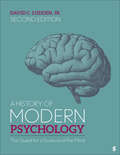
A History of Modern Psychology: The Quest for a Science of the Mind
Par David Ludden. 2026
A History of Modern Psychology: The Quest for a Science of the Mind describes the evolution of psychology into the…
twenty-first century with coverage of recent events and findings that transform our understanding of the past. With a topical approach that presents key thinkers within the context of schools of thought, students are able to see how philosophers, researchers, and academics influenced one another to create the rich and diverse landscape of modern psychology in a global context. In the new Second Edition, the author expands coverage of unsung pioneers (philosopher Al-Balkhi, zoologist Charles Henry Turner, psychiatrist Grunya Sukhareva, and others), revisits the legacy of Francis Galton, explores the "Vygotsky boom," and includes new discussion of the impact of Philip Zimbardo′s Stanford Prison Experiment. Through detailed timelines and features such as "Looking Back" and "Looking Ahead," Ludden gives students a deeper appreciation for the transference of knowledge that shaped the field.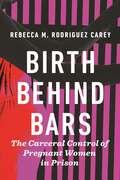
Birth Behind Bars: The Carceral Control of Pregnant Women in Prison
Par Rebecca M. Carey. 2025
Pregnant women's experiences in prisonFour percent of incarcerated women—more than three thousand—are pregnant in US prisons each year, yet little…
information is known about their pregnancy, birth, postpartum, and motherhood experiences. In Birth Behind Bars, Rebecca M. Rodriguez Carey draws on in-depth interviews with women who were once pregnant in prisons in the heart of the Midwest to provide a rare, intimate portrait into the intersection of motherhood and incarceration.Using a reproductive-justice framework and narrative accounts, Rodriguez Carey shows how the prison system works alongside other carceral systems, such as the medical system and the child welfare system, to regulate and control women. She reveals how their incarceration goes beyond the function of criminal punishment, threatening both maternal and fetal health and the well-being of families. Birth Behind Bars offers an evocative account of how these powerful carceral systems collectively disrupt entire families and communities during pregnancy, birth, and the postpartum period, including long after women are released from prison.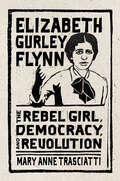
Elizabeth Gurley Flynn: The Rebel Girl, Democracy, and Revolution (CERES: Rutgers Studies in History)
Par Mary Anne Trasciatti. 2025
Elizabeth Gurley Flynn was involved in almost every major campaign of the U.S. Left in the first two thirds of…
the twentieth century. An outstanding orator, writer, and tactician, Flynn is one of the most important figures in the history of the American labor movement. Inspired by the Irish freedom struggle and appalled by the exploitation and grinding poverty she saw around her, she devoted her life to the advancement of civil liberties. Here, Mary Anne Trasciatti traces Flynn’s personal and political life to explore the broader social issues of a fraught era. Born in 1890, Flynn began her activist career by joining the Industrial Workers of the World (IWW) when she was just sixteen, and she ended it as the first female chair of the American Communist Party, a position she held from 1961 until her death in 1964. In the intervening years she organized workers into unions, led strikes, championed women’s rights, supported anti-imperialist movements around the globe, protested deportation, advocated for prison reform, and fought for Black liberation. Above all, she showed absolute devotion to workers and their struggles. Slandered as an “un-American” in the anticommunist fervor of the 1940s and 1950s, Flynn was eventually ousted from the very organization she helped found, the American Civil Liberties Union, and imprisoned for two years. Though her own movement abandoned her, her commitment to the cause never wavered. This stirring biography illuminates Flynn’s inspiring life and worldview and returns her to her rightful place at the heart of labor and civil liberties history.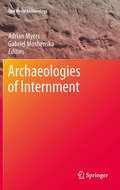
Archaeologies of Internment (One World Archaeology)
Par Gabriel Moshenska, Adrian Myers. 2007
The internment of civilian and military prisoners became an increasingly common feature of conflicts in the twentieth century and into…
the twenty-first. Prison camps, though often hastily constructed and just as quickly destroyed, have left their marks in the archaeological record. Due to both their temporary nature and their often sensitive political contexts, places of internment present a unique challenge to archaeologists and heritage managers. As archaeologists have begun to explore the material remains of internment using a range of methods, these interdisciplinary studies have demonstrated the potential to connect individual memories and historical debates to the fragmentary material remains. Archaeologies of Internment brings together in one volume a range of methodological and theoretical approaches to this developing field. The contributions are geographically and temporally diverse, ranging from Second World War internment in Europe and the USA to prison islands of the Greek Civil War, South African labor camps, and the secret detention centers of the Argentinean Junta and the East German Stasi. These studies have powerful social, cultural, political, and emotive implications, particularly in societies in which historical narratives of oppression and genocide have themselves been suppressed. By repopulating the historical narratives with individuals and grounding them in the material remains, it is hoped that they might become, at least in some cases, archaeologies of liberation.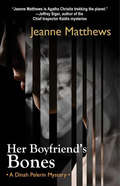
Her Boyfriend's Bones: A Dinah Pelerin Mystery (Dinah Pelerin Mysteries #4)
Par Jeanne Matthews. 2013
In 1973, on a remote beach on the Greek island of Samos, a movie star named Marilita Stephan murdered her…
boyfriend, his mother,and a powerful colonel in the military junta, a crime for which she was executed. Forty years later, Dinah Pelerinarrives on Samos to spend the summer with her Norwegian boyfriend Thor before she joins an archaeological dig nearby. A policeman on sabbatical, Thor seems unduly fascinated by the murders and Dinah soon discovers that the had more than romance in mind when he chose their holiday destination. Guns supplied to the former junta by the American CIA have turned up in Norway in the hands of terrorists and Norwegian intelligence has traced the source of the weapons to Samos. The island has become a transit point for refugees fleeing the Middle East. When an Iraqi immigrantwith a fake ID is killed, Thor suspects a link to the arms traffickers. But before he can investigate, his car plunges off a cliff and he disappears.Greece's economic woes have bred corruption and Dinah fears that he was betrayed by local police and either kidnapped or murdered. Unable to trust anyone, she sets out to find him. The deeper she digs, the more connections she sees between the present crime wave and what happened in 1973. Marilitamay have been innocent and the fate of her boyfriend holds eerie parallels to Thor's disappearance. Dinah must be smarter and braver than she's ever been to prevent another Greek tragedy.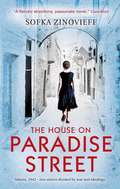
The House on Paradise Street
Par Sofka Zinovieff. 2011
In 2008 Antigone Perifanis returns to her old family home in Athens after 60 years in exile. She has come…
to attend the funeral of her only son, Nikitas, who was born in prison, and whom she has not seen since she left him as a baby. At the same time, Nikitas's English widow Maud - disturbed by her husband's strange behaviour in the days before his death - starts to investigate his complicated past. She soon finds herself reigniting a bitter family feud, and discovers a heartbreaking story of a young mother caught up in the political tides of the Greek Civil War, forced to make a terrible decision that will blight not only her life but that of future generations...
Proof: The Uncertain Science of Certainty
Par Adam Kucharski. 2025
'Profound and utterly absorbing. Kucharski elegantly explores how proof is not just a mathematical concept but a vital tool in…
decision-making, justice, and survival' CHRIS VAN TULLEKENHow far would you go in your search for certainty? And once you get there, how do you convince others?From the medieval Islamic world to the recent pandemic, scientific progress has relied on different methods of establishing fact from fiction. Today, in the face of ever- increasing disinformation, how we prove things - to ourselves and others - has never felt more urgent.But there is far more to proof than axioms, theories and scientific laws: when demonstrating that an experimental medical treatment works, persuading a jury of someone's guilt, or deciding whether to trust a new type of financial transaction, weighing up evidence is rarely simple.Bestselling author, statistician and epidemiologist Adam Kucharski ranges across science, politics, philosophy and economics to explore how truth emerges - and why it falters.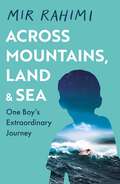
Across Mountains, Land and Sea: One Boy’s Extraordinary Journey
Par Mir Rahimi. 2025
The extraordinary true story of hope, courage and survival and one boy's journey across the world to find safety When…
Mir was thirteen, he was forced to flee his village in the mountains of Afghanistan. Separated from his family he embarked on an astonishing journey across snowy mountains, treacherous land and unforgiving seas, until he reached Dover clinging to the underside of a lorry. It was in the UK that he realised his journey had only just begun. This is Mir's unbelievable story of seeking a better life and education, and the marks left by displacement.
Whales, They Give Themselves: Conversations with Harry Brower, Sr.
Par Karen Brewster. 2004
The Whales, They Give Themselves is an intimate life history of Harry Brower, Sr. (1924-1992), an Inupiaq whaling captain, artisan,…
and community leader from Barrow, Alaska. In a life that spanned the profound cultural and economic changes of the twentieth century, Brower's vast knowledge of the natural world made him an essential contributor to the Native and scientific communities of the North. His desire to share his insights with future generations resulted in a series of conversations with friend and oral historian Karen Brewster, who weaves Harry's stories with cultural and historical background into this innovative and collaborative oral biography. Brower was deeply committed to Native culture, and his life history is a moving expression of the Inupiaq way of life. He was also influential in traditionally non-Native arenas in which Native and non-Native values sometimes collided. Acting as a mediator between Inupiaq whalers and non-Native scientists, Brower communicated a vast understanding of bowhead whales and whaling that became the basis for a scientific research program and helped protect Inupiaq subsistence whaling. He was a central architect of the Arctic Slope Regional Corporation boundaries, and served for over twenty years as a consultant to scientists at the Naval Arctic Research Laboratory. Brower's role in this collaborative research serves as one of the earliest and best examples of how scientists and Native experts can work together to advance knowledge. Such approaches are now promoted by researchers around the world. The Whales, They Give Themselves not only conveys Brower's life story, but also is a cross-cultural journey of wisdom and friendship. Whereas academic oral historians once strove to erase the presence of the interviewer in the name of objectivity, Brewster recognizes the influence her specific relationship with Brower had on the way he narrated his life. This volume is a major contribution to our understanding of northern peoples, and a testament to the immense value of collaborative oral history.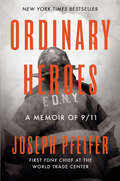
Ordinary Heroes: A Memoir of 9/11
Par Joseph Pfeifer. 2021
New York Times BestsellerFrom the first FDNY chief to respond to the 9/11 attacks, an intimate memoir and a tribute…
to those who died that others might liveWhen Chief Joe Pfeifer led his firefighters to investigate an odor of gas in downtown Manhattan on the morning of 9/11, he had no idea that his life was about to change forever. A few moments later, he watched as the first plane crashed into the World Trade Center. Pfeifer, the closest FDNY chief to the scene, spearheaded rescue efforts on one of the darkest days in American history.Ordinary Heroes is the unforgettable and intimate account of what Chief Pfeifer witnessed at Ground Zero, on that day and the days that followed. Through his eyes, we see the horror of the attack and the courage of the firefighters who ran into the burning towers to save others. We see him send his own brother up the stairs of the North Tower, never to return. And we walk with him and his fellow firefighters through weeks of rescue efforts and months of numbing grief, as they wrestle with the real meaning of heroism and leadership.This gripping narrative gives way to resiliency and a determination that permanently reshapes Pfeifer, his fellow firefighters, NYC, and America. Ordinary Heroes takes us on a journey that turns traumatic memories into hope, so we can make good on our promise to never forget 9/11.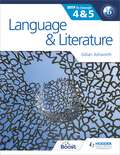
Language and Literature for the IB MYP 4 & 5: By Concept (MYP By Concept)
Par Gillian Ashworth. 2019
The only series for MYP 4 and 5 developed in cooperation with the International Baccalaureate (IB)Develop your skills to become…
an inquiring learner; ensure you navigate the MYP framework with confidence using a concept-driven and assessment-focused approach to Language and Literature presented in global contexts.- Develop conceptual understanding with key MYP concepts and related concepts at the heart of each chapter.- Learn by asking questions with a statement of inquiry in each chapter. - Prepare for every aspect of assessment using support and tasks designed by experienced educators.- Understand how to extend your learning through research projects and interdisciplinary opportunities.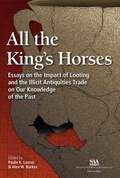
This volume from the SAA Press examines the impact of looting and the use of artifacts of unknown provenance in…
the humanities and social sciences, ranging from the impact of amnesty laws for reporting stolen cultural property to the use of Google Earth to assess the scale of illicit excavations, and from the impact of poorly sourced artifacts on early Mycenaean and Minoan studies to the structure of the growing commercial trade in ancient coins.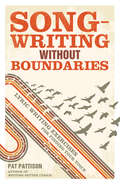
Songwriting Without Boundaries: Lyric Writing Exercises for Finding Your Voice
Par Pat Pattison. 2011
Infuse your lyrics with sensory detail!Writing great song lyrics requires practice and discipline. Songwriting Without Boundaries will help you commit…
to routine practice through fun writing exercises. This unique collection of more than150 sense-bound prompts helps you develop the skills you need to: • tap into your senses and inject your writing with vivid details • effectively use metaphor and comparative language • add rhythm to your writing and manage phrasingSongwriters, as well as writers of other genres, will benefit from this collection of sensory writing challenges. Divided into four sections, Songwriting Without Boundaries features four different fourteen-day challenges with timed writing exercises, along with examples from other songwriters, poets, and prose writers.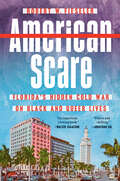
American Scare: Florida's Hidden Cold War on Black and Queer Lives
Par Robert W. Fieseler. 2025
A vital exposé for both our history and our present day, American Scare tells the riveting story of how the…
Florida government destroyed the lives of Black and queer citizens in the twentieth century. In January 1959, Art Copleston was escorted out of his college accounting class by three police officers. In a motel room, blinds drawn, he sat in front of a state senator and the legal counsel for the Florida Legislative Investigation Committee, nicknamed the &“Johns Committee.&” His crime? Being a suspected homosexual. And the government of Florida would use any tactic at their disposal—legal or not—to get Copleston to admit it. Using a secret trove of primary source documents that have been decoded and de-censored for the first time in history, journalist Robert Fieseler unravels the mystery of what actually happened behind the closed doors of an inquisition that held ordinary citizens ransom to its extraordinary powers. The state of Florida would prefer that this history remain buried. But for nearly a decade, the Florida Legislature founded, funded, and supported the Johns Committee—an organization using the cover of communism to viciously attack members of the NAACP and queer professors and students. Spearheaded by Charley Johns, a multi-term politician in a gerrymandered legislature, the Committee was determined to eliminate any threats to the state's white, conservative regime. Fieseler describes the heartbreaking ramifications for citizens of Florida whose lives were imperiled, profiling marginalized residents with compassion and a determination to bring their devasting experiences to light at last. A propulsive, human-centered drama, with fascinating insight into Florida politics, American Scare is a page-turning reckoning of our racist and homophobic past—and its chilling parallels to today.